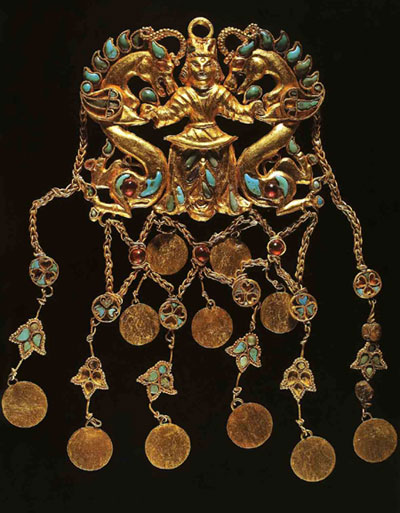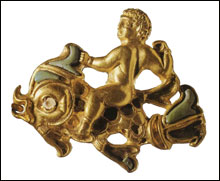
Pendants dites The sovereign and the dragons Gold, garnets, turquoises and lapis-lazuli. Kabul Museum Collection
DR |
|
MUSÉE DES ARTS ASIATIQUES GUIMET
6, place d’Iéna – 75116 Paris
INFORMATION:
Tél : 01 56 52 53 00 Fax : 01 56 52 53 54
Site : www.guimet.fr
OPENING HOURS:
Everyday except Tuesdays, from 10 am to
6 pm.
Last admissions at 5.45 pm
ADMISSION FEES:
Admission: € 7, concessions € 5. Free for under 18’s
Combined ticket (museum+exhibition): € 8.50, concessions € 6
Tickets for professionals and groups tickets can be purchased in advance; Advance booking: Musée & Compagnie.
For individuals advance booking available in the FNAC and Carrefour stores.
CURATORSHIP:
Jean-François Jarrige, Commissioner in Chief
Pierre Cambon, Chief Currator of the Heritage of the Afghan/Pakistani section
Museography: Massimo Quendolo, architect DPLG
PRESS CONTACT:
Hélène Lefèvre – PR/Press
Tel: +33 (0)1 56 52 53 32
E-mail : helene.lefevre@guimet.fr

|
Afghanistan, the story of a thousand years, which went on show in March 2002, the Guimet Museum will put findings from four major archaeological sites - Fulol, Aï-Khanoum, Tillia-Tepe and Begram - on display to the public. Behind the unique and exciting story of these rediscovered treasures, the exhibition pays tribute to the history of Afghanistan, which lay at the centre of kingdoms and empires extending all the way from Central Asia to northern India. Thanks to the outstanding display of 220 items, the exhibition gives a perspective on the development of Afghan history, from the Bronze Age to the Kushan empire
Continuity, uniqueness and wealth of the Afghan heritage
Even though the objects displayed have different geographical and historical origins, they also celebrate the continuity, the uniqueness and the wealth of the Afghan heritage, in a region that has been influenced by so many cultures: Iranian and Near Eastern, Indian, Scythian, Chinese and Hellenistic. The golden vases from Fulol hark back to the Bactrian civilisation (2200-1800 BC) and to the vital role played by that region in the exchanges between the Middle East and the Indus civilisation.
Another site of world renown, the Aï-Khanoum site (end of the 4th century to the mid 2nd century BC), was discovered and then excavated by the French Archaeological Delegation in Afghanistan (DAFA), between 1964 and 1978. It demonstrates just how far Hellenism penetrated into Central Asia, and the lasting influence of this culture in the region. The gold ingots remind us just how wealthy the Greek adventurers were, while the Cybele plate illustrates the symbiotic relationship with more oriental traditions.
Objects most representative of the Kabul collections
The necropolis of Tillia-Tepe, the “golden hill” (1st Century), at the northern border was the last major discovery made before Afghanistan was plunged into chaos. Six intact princely tombs, containing some very beautiful funerary decorations, were excavated by a team of Afghano-Soviet archaeologists, supervised by Victor Sariandi. Pendants, a belt, Chinese mirrors, Indian ivory and even Greco-Roman intaglio all serve to underline Afghanistan’s strategic position on the Steppe Route.
The Begram treasure marks a development, by showing how the centre of power shifted southwards. The objects found by DAFA in 1937 and 1939 therefore bear witness to the power and wealth of a court which was believed to be Kushan when it was discovered (1st to 3rd Centuries); a court under the influence of the Indian, Chinese and Greek worlds. The exhibition brings together certain objects most representative of the Kabul collections, such as Indian ivories, Hellenistic bronzes, even a batch of glassware which appears to be the oldest example of Greco-Roman glasses.
Restauring and reintegrating
The exhibition is accompanied by the restoration of a great many works with the aim of re-integrating them into the Kabul museum collections. The presentation reveals a very particular facet of Afghanistan, given the current political climate. Through this restoration, and by giving due acknowledgement to the marvellous Afghan heritage, as well as tothe cultural influences which fed into it, this unique exhibition reminds us of the fragility of these treasures, and the necessity of protecting them. Indeed, these sites are loci memoriae for the Afghan people, in a country which is slowly and gradually trying to reconstruct itself.
PUBLICATION
Exhibition’s catalogue published by RMN / musée Guimet: € 48
Illustration : Hooks representing a cupid riding a dolphin (a pair) Dress clasp in gold, greco-roman inspiration. Dolphin eyes set with pearls. Kabul Museum Collection DR
To see more illustrations, click on VERSION FRANCAISE at the top of this page
|









